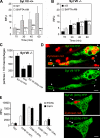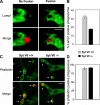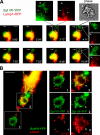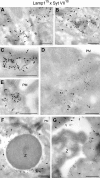Ca2+ and synaptotagmin VII-dependent delivery of lysosomal membrane to nascent phagosomes
- PMID: 16982801
- PMCID: PMC2064391
- DOI: 10.1083/jcb.200605004
Ca2+ and synaptotagmin VII-dependent delivery of lysosomal membrane to nascent phagosomes
Abstract
Synaptotagmin (Syt) VII is a ubiquitously expressed member of the Syt family of Ca2+ sensors. It is present on lysosomes in several cell types, where it regulates Ca2+-dependent exocytosis. Because [Ca2+]i and exocytosis have been associated with phagocytosis, we investigated the phagocytic ability of macrophages from Syt VII-/- mice. Syt VII-/- macrophages phagocytose normally at low particle/cell ratios but show a progressive inhibition in particle uptake under high load conditions. Complementation with Syt VII rescues this phenotype, but only when functional Ca2+-binding sites are retained. Reinforcing a role for Syt VII in Ca2+-dependent phagocytosis, particle uptake in Syt VII-/- macrophages is significantly less dependent on [Ca2+]i. Syt VII is concentrated on peripheral domains of lysosomal compartments, from where it is recruited to nascent phagosomes. Syt VII recruitment is rapidly followed by the delivery of Lamp1 to phagosomes, a process that is inhibited in Syt VII-/- macrophages. Thus, Syt VII regulates the Ca2+-dependent mobilization of lysosomes as a supplemental source of membrane during phagocytosis.
Figures








Similar articles
-
Palmitoylation-dependent association with CD63 targets the Ca2+ sensor synaptotagmin VII to lysosomes.J Cell Biol. 2010 Nov 1;191(3):599-613. doi: 10.1083/jcb.201003021. J Cell Biol. 2010. PMID: 21041449 Free PMC article.
-
Differential role of the Ca(2+) sensor synaptotagmin VII in macrophages and dendritic cells.Immunobiology. 2009;214(7):495-505. doi: 10.1016/j.imbio.2008.11.006. Epub 2009 Jan 20. Immunobiology. 2009. PMID: 19157638 Free PMC article.
-
The exocytosis regulator synaptotagmin V controls phagocytosis in macrophages.J Immunol. 2008 Oct 15;181(8):5289-95. doi: 10.4049/jimmunol.181.8.5289. J Immunol. 2008. PMID: 18832684
-
There's more to life than neurotransmission: the regulation of exocytosis by synaptotagmin VII.Trends Cell Biol. 2005 Nov;15(11):626-31. doi: 10.1016/j.tcb.2005.09.001. Epub 2005 Sep 15. Trends Cell Biol. 2005. PMID: 16168654 Review.
-
The high-affinity calcium sensor synaptotagmin-7 serves multiple roles in regulated exocytosis.J Gen Physiol. 2018 Jun 4;150(6):783-807. doi: 10.1085/jgp.201711944. Epub 2018 May 24. J Gen Physiol. 2018. PMID: 29794152 Free PMC article. Review.
Cited by
-
Rab GTPases take centre stage in understanding Entamoeba histolytica biology.Small GTPases. 2020 Sep;11(5):320-333. doi: 10.1080/21541248.2018.1528840. Epub 2018 Oct 13. Small GTPases. 2020. PMID: 30273093 Free PMC article. Review.
-
NK cells and monocytes modulate primary HTLV-1 infection.PLoS Pathog. 2022 Apr 4;18(4):e1010416. doi: 10.1371/journal.ppat.1010416. eCollection 2022 Apr. PLoS Pathog. 2022. PMID: 35377924 Free PMC article.
-
Active ras triggers death in glioblastoma cells through hyperstimulation of macropinocytosis.Mol Cancer Res. 2008 Jun;6(6):965-77. doi: 10.1158/1541-7786.MCR-07-2036. Mol Cancer Res. 2008. PMID: 18567800 Free PMC article.
-
Shaping cups into phagosomes and macropinosomes.Nat Rev Mol Cell Biol. 2008 Aug;9(8):639-49. doi: 10.1038/nrm2447. Epub 2008 Jul 9. Nat Rev Mol Cell Biol. 2008. PMID: 18612320 Free PMC article. Review.
-
Two-pore channels in MR1-dependent presentation of Mycobacterium tuberculosis infection.PLoS Pathog. 2025 Aug 4;21(8):e1013342. doi: 10.1371/journal.ppat.1013342. eCollection 2025 Aug. PLoS Pathog. 2025. PMID: 40758737 Free PMC article.
References
-
- Aderem, A., and D.M. Underhill. 1999. Mechanisms of phagocytosis in macrophages. Annu. Rev. Immunol. 17:593–623. - PubMed
-
- Advani, R.J., H.R. Bae, J.B. Bock, D.S. Chao, Y.C. Doung, R. Prekeris, J.S. Yoo, and R.H. Scheller. 1998. Seven novel mammalian SNARE proteins localize to distinct membrane compartments. J. Biol. Chem. 273:10317–10324. - PubMed
Publication types
MeSH terms
Substances
Grants and funding
LinkOut - more resources
Full Text Sources
Other Literature Sources
Molecular Biology Databases
Miscellaneous

